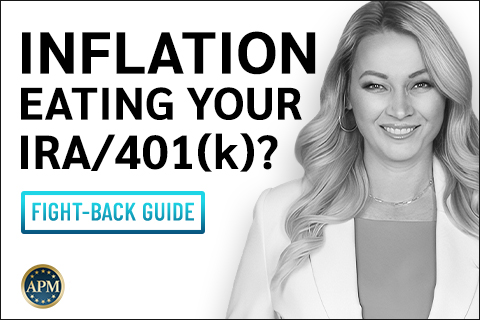Affiliate Disclosure
The owners of this website may be paid to recommend the following companies: Goldco, Augusta Precious Metals, Noble Gold Investments, and Birch Gold Group. The content on this website, including any positive reviews of the mentioned companies, and other reviews, may not be neutral or independent. We do believe in all the companies we recommend as being the most trustworthy in the business.
Are you looking to diversify your portfolio and increase its potential returns? Investing in gold may be a great way to do this. Gold has been a trusted store of value for thousands of years, and many investors are now turning to gold as an important component of their investment portfolios. In this ultimate guide, we’ll provide you with all the information you need to know about how to buy gold in your portfolio. We’ll explore the different types of gold investments, explain the risks and rewards associated with each type, and provide tips on how to maximize your return on investment. So read on to learn more about how to buy gold in your portfolio!
Why add gold to your portfolio?
Investing in gold has long been considered a smart move for diversifying your portfolio and potentially increasing its returns. But why exactly should you add gold to your investment mix?
First and foremost, gold is a trusted store of value. It has been used as a form of currency and a store of wealth for thousands of years. While the value of other assets, such as stocks and bonds, can fluctuate based on economic conditions, gold has proven to hold its value over time. This makes it a reliable asset to have in your portfolio, especially during times of market volatility or economic uncertainty.

Secondly, gold can act as a hedge against inflation. Inflation occurs when the purchasing power of a currency decreases over time. As prices rise, the value of your money diminishes. However, gold has historically been able to preserve its value during periods of high inflation. By holding gold in your portfolio, you can help protect your wealth from the eroding effects of inflation.
Additionally, gold has a low correlation with other asset classes. This means that its value tends to move independently of stocks, bonds, and other traditional investments. By including gold in your portfolio, you can reduce the overall risk and volatility of your investments. This can be especially beneficial during times of market downturns, as gold often acts as a safe haven asset.
Furthermore, gold is a globally recognized asset. It is accepted and traded around the world, making it highly liquid. This means that you can easily buy or sell gold at any time without significant price fluctuations. The liquidity of gold makes it a highly flexible asset to have in your portfolio, allowing you to quickly adjust your holdings based on changing market conditions.
In summary, adding gold to your portfolio can provide several benefits. It can serve as a reliable store of value, act as a hedge against inflation, reduce overall portfolio risk, and offer liquidity and flexibility. By including gold in your investment mix, you can potentially enhance your portfolio’s performance and protect your wealth over the long term.
Different ways to invest in gold
When it comes to investing in gold, there are several different ways you can go about it. Each method has its own advantages and considerations, so it’s important to understand the options available to you. Here are some different ways to invest in gold:
- Physical gold: This is perhaps the most traditional form of investing in gold. You can purchase physical gold in the form of bullion bars or coins. The advantage of physical gold is that you have ownership of a tangible asset. However, there are considerations such as storage and security.
- Gold ETFs: Exchange-traded funds (ETFs) are investment funds that trade on stock exchanges. There are gold ETFs that are backed by physical gold. This allows you to gain exposure to the price of gold without actually owning physical gold. The advantage of gold ETFs is that they are highly liquid and can be bought and sold like stocks.
- Gold mining stocks: Another way to invest in gold is through gold mining stocks. These are stocks of companies involved in gold mining and exploration. When the price of gold goes up, the value of these stocks tends to increase as well. Investing in gold mining stocks allows you to potentially benefit from the success of gold mining companies.
- Gold futures and options: For more advanced investors, gold futures and options can be an option. These are contracts that allow you to buy or sell gold at a predetermined price at a future date. Futures and options trading can be complex and risky, so it’s important to have a good understanding of the market before getting involved.
- Gold IRAs: A gold IRA, or Individual Retirement Account, allows you to hold physical gold in your retirement account. This can provide a way to diversify your retirement savings and potentially protect it from inflation. With a gold IRA, you can purchase gold coins or bars and have them held in a secure depository.
Each of these investment options has its own pros and cons, so it’s important to carefully consider your investment goals, risk tolerance, and time horizon before making a decision. It may also be wise to consult with a financial advisor who can help guide you through the process.
Limited Time offer!
Researching and selecting a reputable dealer
When it comes to buying gold for your portfolio, one of the most important steps is researching and selecting a reputable dealer. Choosing the right dealer can ensure that you are getting genuine and high-quality gold, and that your investment is safe and secure.
To start, it’s crucial to do thorough research on potential dealers. Look for dealers who have a strong reputation in the industry and a track record of customer satisfaction. Online reviews and testimonials can provide valuable insights into the experiences of other investors. You can also check with industry organizations or regulatory bodies to see if any complaints have been filed against the dealer.
Another factor to consider is the dealer’s experience and expertise. Look for dealers who have been in business for a significant amount of time and have a deep understanding of the gold market. An experienced dealer can provide valuable advice and guidance based on their knowledge of market trends and investment strategies.
Transparency is also key when selecting a dealer. Make sure the dealer provides clear information about the pricing, fees, and terms of the transaction. They should be able to answer any questions you have and provide documentation or certificates of authenticity for the gold they are selling.
It’s also worth considering the dealer’s storage and delivery options. If you are purchasing physical gold, you’ll want to ensure that the dealer can securely store and deliver the gold to you. Ask about their storage facilities, insurance coverage, and shipping methods to ensure that your investment is protected.
Lastly, don’t be afraid to reach out to the dealer and ask for references or speak to their previous customers. This can give you firsthand insights into the dealer’s reliability, customer service, and overall experience.
By taking the time to research and select a reputable dealer, you can have peace of mind knowing that your investment in gold is in good hands. A trusted dealer can help ensure that you are making a smart and secure investment, and can provide valuable guidance throughout your gold buying journey. So be diligent in your research, ask the right questions, and choose a dealer that you feel confident in.
Our Top Trusted Company Picks for 2023
Our recommended Providers are researched and vetted by us and many top consumer organizations. This is the short list of the most consistent companies we could come up with. Request information from them below.
#1: Augusta Precious Metals
Our Rating: 10/10
Pros
✅ ZERO complaints with the BBB and BCA
✅ Highest reputation and customer satisfaction in the industry
✅ The best “White Glove” service!
✅ Non-commissioned sales team
✅ Transparent pricing with up to 10 years of fees waved – with qualifying purchase.
✅ Hall of fame quarterback, Joe Montana was an actual customer before becoming their spokesperson!
Call Augusta for your free gold kit now:
1-855-470-4636
Get FREE Gold when you open a gold IRA!
#2: Birch Gold Group
Our Rating: 9.9/10
Pros
✅ Great company commitment to education and communication
✅ Impeccable customer service
✅ Silver, gold, platinum and palladium available
Cons
❌ Signup process can only be done thought a specific link
❌ No buyback guarantee of precious metals
#3: Noble Gold Investments
Our Rating: 9.9/10
Pros
✅ One of the best no questions asked buyback programs in the industry
✅ Free delivery of your precious metals to your door at any time
✅ Over 20 years of experience in the precious metals industry
✅ Gold, silver, platinum, and palladium available
✅ Secure, exclusive storage in the
State of Texas
✅ One of the lowest barriers to entry – ideal for smaller investors
Cons
❌ High annual fees for low balances
❌ Offers common bullion only. Does not offer premium bullion or collectible coins
Call Noble Gold for your FREE Investing Kit!
1-626-684-4908
Understanding the costs involved
Investing in gold can be an excellent way to diversify your portfolio and potentially increase your returns. However, it’s important to understand the costs involved in buying and owning gold before you make a decision.
When it comes to buying gold, there are several costs to consider. The first is the premium. This is the amount you pay above the spot price of gold. The premium can vary depending on the type of gold you’re buying and the dealer you’re purchasing it from. For example, gold coins typically have higher premiums than gold bars due to factors such as rarity and craftsmanship.
In addition to the premium, you’ll also need to consider the cost of storage. If you’re buying physical gold, you’ll need a safe and secure place to store it. This could be a safe deposit box at a bank or a private vaulting service. These services come with a fee, so it’s important to factor in this cost when determining your overall investment.
Another cost to consider is insurance. It’s important to insure your gold to protect your investment in case of theft, damage, or loss. The cost of insurance will vary depending on the value of your gold and the insurance provider you choose.

Additionally, if you’re buying gold through an ETF or a gold mining stock, you’ll need to consider any associated fees. ETFs typically charge a management fee, which is a percentage of your investment, while gold mining stocks may charge transaction fees or management fees.
Lastly, it’s important to consider the cost of selling your gold. Whether you’re selling physical gold or selling shares of an ETF or gold mining stock, there may be fees associated with the sale. These fees can vary depending on the dealer or brokerage you use, so it’s important to research and compare costs before making a decision.
Understanding the costs involved in buying and owning gold is crucial for making an informed investment decision. By factoring in the premiums, storage fees, insurance costs, and potential selling fees, you can determine the true cost of owning gold and ensure that it aligns with your investment goals and budget. So be sure to do your due diligence and consider all the costs before adding gold to your portfolio.
Making the purchase – options for payment and delivery
Once you have decided to add gold to your investment portfolio, the next step is making the actual purchase. When it comes to buying gold, there are various options available for payment and delivery.
Payment options for purchasing gold can include cash, credit/debit cards, wire transfers, or even cryptocurrency in some cases. It is essential to choose a payment method that is secure and convenient for you. Keep in mind that certain payment methods may incur additional fees or processing times, so be sure to consider these factors when making your decision.

When it comes to delivery, the method will depend on the type of gold you are purchasing. If you are buying physical gold such as bullion bars or coins, you may have the option to pick up your gold in person from the dealer or have it delivered to your doorstep. It is important to ensure that the delivery method is secure and insured to protect your investment during transit.
Many reputable dealers offer insured shipping options, providing peace of mind that your gold will be protected in case of any unforeseen events. Some dealers may also offer storage services, where they can securely store your gold on your behalf. This can be a convenient option if you do not have access to secure storage facilities or prefer not to store your gold at home.
Additionally, if you are purchasing gold through an ETF or gold mining stocks, the delivery process will be different. In these cases, you will not physically receive the gold but rather hold shares or certificates that represent your ownership.
When making the purchase, it is crucial to choose a dealer or platform that offers reliable and secure payment and delivery options. Look for dealers with a good reputation, transparent policies, and clear communication channels. Research their payment and delivery methods, read customer reviews, and compare prices and fees to ensure you are getting the best value for your investment.
Storing and securing your physical gold
Now that you’ve purchased physical gold for your portfolio, it’s essential to consider how to store and secure it. Physical gold requires special attention to ensure its safety and protection.
First and foremost, you’ll need to find a secure storage option for your gold. Keeping it at home may seem convenient, but it also poses potential risks, such as theft or damage. Instead, consider storing your gold in a secure off-site location, such as a bank’s safe deposit box or a private vaulting service. These facilities are specifically designed to protect valuable assets like gold and often offer enhanced security measures like surveillance cameras, alarm systems, and even armed guards.
When choosing a storage facility, be sure to consider factors such as accessibility, insurance coverage, and reputation. Look for a facility that has a proven track record of security and a high level of customer satisfaction. It’s also essential to review the terms and conditions of the storage agreement, including any fees, insurance coverage, and access protocols.
Once your gold is safely stored, it’s a good idea to keep detailed records of your holdings. Maintain a comprehensive inventory of the type, weight, and purity of each piece of gold you own. This documentation will not only help you keep track of your assets but also prove ownership and value in case of any future transactions or insurance claims.
In addition to secure storage, consider insuring your physical gold. While storage facilities often have insurance coverage, it’s still a good idea to have your own insurance policy. This will provide an extra layer of protection in case of loss, damage, or theft.
Lastly, regularly inspect and monitor your stored gold. Take the time to periodically visit your storage facility to ensure that your gold is secure and in good condition. Pay attention to any signs of tampering or damage and report any concerns immediately. Regularly reviewing your stored gold will help you identify any issues early on and take appropriate action to safeguard your investment.
By taking the necessary steps to store and secure your physical gold, you can have peace of mind knowing that your investment is protected. With the right storage facility, proper insurance coverage, and regular monitoring, you can confidently hold onto your physical gold as a valuable asset in your portfolio.
Regularly reviewing and rebalancing your portfolio
One of the keys to successful investing is regularly reviewing and rebalancing your portfolio, and this applies to your gold investments as well. While gold is often considered a stable and long-term asset, it’s still important to regularly assess its performance and make adjustments as needed.
When reviewing your portfolio, start by evaluating the overall performance of your gold investments. Consider factors such as the price of gold, any changes in the market, and how gold is performing relative to your other investments. If you notice that the value of your gold holdings has significantly increased or decreased, it may be a sign that your portfolio needs rebalancing.
Rebalancing your portfolio involves adjusting the allocation of your assets to maintain your desired risk level and investment objectives. If the value of your gold holdings has increased significantly, you may want to consider selling a portion of your gold and reinvesting the proceeds in other assets to maintain a balanced portfolio. On the other hand, if the value of your gold holdings has decreased, you may want to consider adding more gold to your portfolio to take advantage of potential future gains.
It’s also important to consider any changes in your financial goals or risk tolerance. As your circumstances and investment goals change over time, your portfolio may need to be adjusted accordingly. For example, if you have a shorter time horizon for your investments, you may want to decrease your exposure to gold and allocate more of your portfolio to assets with potentially higher returns.
Regularly reviewing and rebalancing your portfolio not only helps you maximize the potential returns on your investments but also allows you to stay aligned with your long-term financial goals. It’s recommended to conduct a thorough portfolio review at least once a year or whenever significant changes occur in the market or your personal circumstances.
Tax implications of investing in gold
When it comes to investing in gold, it’s important to consider the tax implications. While gold can provide significant benefits to your portfolio, it’s crucial to understand how it will be taxed and how it may impact your overall investment strategy.
One of the key things to keep in mind is that the tax treatment of gold can vary depending on the type of investment you choose. For example, if you invest in physical gold such as bullion bars or coins, any gains you make from selling the gold may be subject to capital gains tax. This tax is typically applied to the difference between the purchase price and the selling price of the gold.
However, it’s important to note that the tax rate on capital gains can vary depending on various factors, such as your income level and how long you held the gold before selling it. For short-term capital gains (assets held for less than a year), the tax rate is typically based on your ordinary income tax rate. For long-term capital gains (assets held for more than a year), the tax rate is generally lower and may be based on a flat percentage.
Another important consideration is that gold held in certain retirement accounts, such as a Gold IRA, may offer potential tax advantages. With a Gold IRA, you can hold physical gold in a tax-advantaged account, such as a Traditional IRA or a Roth IRA. Contributions to a Traditional IRA are typically tax-deductible, while distributions from a Roth IRA are tax-free, subject to certain conditions.
By holding gold in a tax-advantaged account, you may be able to defer or potentially eliminate taxes on any gains you make from the sale of the gold. This can be particularly advantageous for individuals looking to maximize their retirement savings and minimize their tax liability.
However, it’s important to consult with a tax professional or financial advisor who can provide guidance on your specific situation. They can help you understand the tax implications of investing in gold and develop a tax-efficient strategy that aligns with your investment goals and overall financial plan.
In summary, investing in gold can have tax implications that need to be considered. Depending on the type of gold investment and how long you hold it, you may be subject to capital gains tax. However, holding gold in a tax-advantaged account, such as a Gold IRA, can offer potential tax advantages. It’s important to consult with a tax professional to understand the specific tax implications and develop a strategy that works best for you.







Pingback: Investing in Gold: A Beginner's Step-by-Step Guide